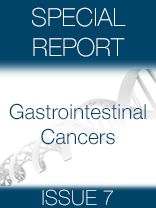ERCC1 Expression Falls Short as Chemo Biomarker in mCRC
A potential biomarker to guide the treatment of patients with metastatic colorectal cancer (mCRC) failed to stratify patients by progression-free survival (PFS) or responsiveness to bevacizumab, according to a randomized trial.
Patients with tumors that exhibited high-level expression of excision repair cross-complementation group 1 (ERCC1) had a median PFS of 9.9 months with mFOLFOX6 plus bevacizumab and 11.2 months with FOLFIRI and bevacizumab. Low baseline tumor expression of ERCC1 was associated with a median PFS of 11.0 versus 12.7 months, with the mFOLFOX6 and FOLFIRI regimens, respectively.
However, these numbers were derived from a small sample size, since relatively few patients met the prespecified cutoff for high expression of ERCC1, lead study author Heinz-Josef Lenz, MD, reported during the meeting. For the most part, the two combination strategies demonstrated similar activity. The only notable exception was tumor location, as patients with left-sided tumors had significantly better PFS with FOLFIRI/bevacizumab.
“Among patients with high ERCC1 levels, there was no statistically significant difference between treatment arms for progression-free or overall survival,” said Lenz, director of the Gastrointestinal Oncology Program at the Keck School of Medicine at the University of Southern California in Los Angeles. “These results should be interpreted with caution due to the lower prevalence of tumor ERCC1.”
Lenz noted that current standard-of-care options for untreated mCRC include modified mFOLFOX6 and FOLFIRI, plus a biologic agent, such as bevacizumab. Whether mFOLFOX6 or FOLFIRI should be preferred for use in combination with anti-VEGF agents has remained unclear.
Some evidence has suggested that ERCC1 is a marker of chemoresistance to platinum-containing chemotherapy. If validated, the marker could have a role in selection of optimal therapy for patients with mCRC.
To compare mFOLFOX6 and FOLFIRI in combination with bevacizumab and evaluate the biomarker potential of ERCC1, investigators in the phase II MAVERICC trial randomized 376 patients 1:1 with previously untreated mCRC. The trial’s primary objective was to determine whether ERCC1 expression has an association with PFS in patients treated with mFOLFOX6 or FOLFIRI plus bevacizumab.
The study population had a median age of 61. Men accounted for about two-thirds of the total, and distribution was even between ECOG 0 and 1 performance status. Also, 70% of patients had localization to the colon, and about 60% had prior surgery.
The two groups had similar treatment duration of about 18.5 months. The FOLFIRI group received about 3 more cycles of bevacizumab (17.6 vs 14.8) and 5-FU (18.4 vs 15.3), in addition to 6 more cycles of irinotecan compared with oxaliplatin (17.5 vs 11.1).
Overall, the mFOLFOX6 group had a median PFS of 10.1 months compared with 12.6 months for the FOLFIRI group, representing a 21% reduction in the hazard ratio, which failed to achieve statistical significance (HR, 0.79; 95% CI, 0.61-1.01;P= .056). Median overall survival (OS) was 23.9 months with mFOLFOX6 and bevacizumab versus 27.5 months with FOLFIRI and bevacizumab, a 24% reduction in the hazard ratio, but also not significant (HR, 0.76; 95% CI, 0.56-1.04; P= .086).
Investigators defined high ERCC1 expression as >1.7 x 10-3ERCC1/ β-actin mRNA, using the cutoff established from prior studies. By that definition, 131 (35%) of patients had high ERCC1 expression.
Patients with high ERCC1 expression had a median PFS of 9.9 months with the mFOLFOX6 regimen and 11.2 months with the FOLFIRI combination (HR, 0.84; 95% CI, 0.56-1.26;P= .394). In the 65% (n = 244) of patients with lower levels of ERCC1 expression, median PFS was 11.0 months with the mFOLFOX6 regimen and 12.7 months with FOLFIRI/bevacizumab (HR, 0.76; 95% CI, 0.55-1.03;P= .079).
Median OS with high ERCC1 expression was 22.5 months with mFOLFOX6 and 26.5 months with FOLFIRI (HR, .80; 95% CI, 0.51-1.26;P= 0.330). In the low-expression patients, mFOLFOX6 led to a median OS of 25.5 months versus 27.9 months with FOLFIRI (HR, 0.74; 95% CI, 0.49-1.12; P= .152).
Analysis of outcomes by tumor location yielded the only significant difference. Patients with right-sided tumors had a median PFS of 10.0 months with the mFOLFOX6 regimen and 11.2 months with FOLFIRI (HR, 0.88; 95% CI, 0.60-1.28;P= .494).
On the other hand, patients with left-side tumor location had a median PFS of 10.2 months with mFOLFOX6 and 13.8 months with FOLFIRI, representing a 29% reduction in the hazard ratio in favor of the FOLFIRI regimen (HR, 0.71; 95% CI, 0.51-0.98;P= .040).
“In the first-line treatment of metastatic colorectal cancer, FOLFIRI/bevacizumab and mFOLFOX6/bevacizumab appeared comparable in this exploratory study with respect to progression-free and overall survival,” Lenz added. “The results could be due, in part, to more treatment cycles administered to patients treated with FOLFIRI/bevacizumab, on average, 6 more cycles of irinotecan than oxaliplatin.”
Adverse event profiles were similar between the two treatment groups, Lenz reported. Grade 3/4 events included uncontrolled hypertension, venous thromboembolic events, bleeding, proteinuria, left ventricular systolic dysfunction, and would dehiscence.
References
- Lenz H-J, Lee F-C, Yau L, et al. MAVERICC, a phase 2 study of mFOLFOX6-bevacizumab (BV) vs FOLFIRI-BV with biomarker stratification as first-line (1L) chemotherapy (CT) in patients (pts) with metastatic colorectal cancer (mCRC). J Clin Oncol. 2016;34 (suppl 4S; abstr 493).
